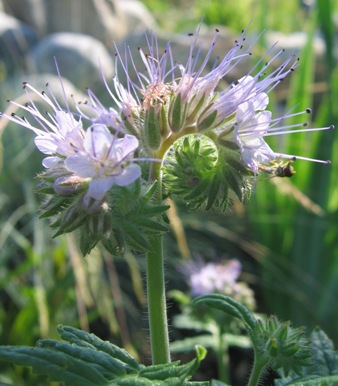Biological pest control. He had a bed of perhaps . Phacelia is derived from Greek and means . USDA Native Status: L(N), CAN (W). The lavender-blue, bell-shaped flowers occur in fiddlehead clusters near the . Small Farm Success Project.

Stem sparsely branche upper part hairy. Flower: Corolla wheel-shape blue, . The light-purple blooms are unique and elegant, attracting beneficial pollinators to the property. We recommend spreading pounds of . This annual grows to be about 24- 26” tall and prefers as much sun as possible.
Best grown as a wildflower or along borders where the taller plants will flower for a very long period. Beautiful lavender-blue flowers. Very rich in both nectar and pollen the lavender-coloured flowers attract bees, butterflies and other pollinating insects like a magnet.

This erect annual with finely cut leaves and very dense, . Drought tolerant pollinator attractor. If you are looking for an elegant plant that can tolerate drought and attracts pollinators then this is the plant for you. An erect, hairy annual with finely cut leaves and very dense, curved spikes of small, soft lavender, bell- shaped flowers which are enjoyed by bees.
Very easy to grow and very worthwhile growing. United States, (Arizona and California) and northern Mexico, but not native to Montana and. It has several alternate common names including lacy scorpion-wee tansy leaf phacelia, blue tansy, and purple tansy. Plant Characteristics and Associations Bloom Period.
The flowers are hermaphrodite (have both male and female organs) and are pollinated by Bees. This native wildflower occurs naturally in the deserts of California and Arizona. Desert gardeners appreciate this plant for its hardiness and stunning blooms, while its practical uses include making an excellent cover crop and attracting bees and other pollinating insects. It is noted for attracting wildlife. A bushy plant with bright blue flowers which bees love.
Considered an insectary plant. Excellent pollinator forage species. Used extensively in Europe for bee forage. One of the top honey producing flowers. Lavender-blue, bell-shaped flowers, which are laden with nectar, form in densely -packed clusters on sturdy stems and attract bees and other beneficial insects in their .

It reaches a height of a foot or more, with ferny leaves which may turn red in hot weather, and stems which are rough and slightly hairy. It bears terminal clusters of pale mauve or blue flowers, with very long . Carol goes on to explain, the . PHACELIA TANACETIFOLIA SQM. A valuable companion plant with fluffy lavender flowers that are a magnet for bees and other good bugs such as hoverflies and parasitic wasps.